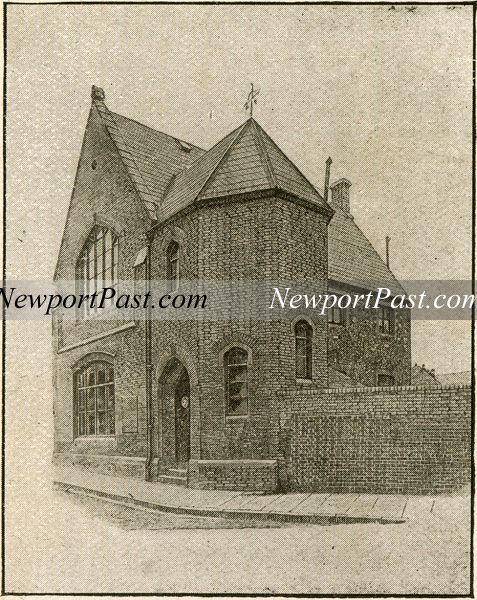The Ragged School, Dock Street, Newport
 Photo reference number: 1551
Photo reference number: 1551
From 'Historic Newport' by James Matthews, 1910.
Used as a temporary free library in 1881-82.
Text from 'Historic Newport':
"The Ragged School, Newport, first originated with Mr. James Jones about the year 1856, who, being actuated by a noble feeling of rescuing much-to-be-pitied children from destruction, with self-devotion and self-sacrifice, commenced the arduous task and opened a 'ragged school' in the neighbourhood of Friars Fields. The school in question was carried on in the long clubroom at the back of the 'Sunderland Inn,' 31 Llanarth Street, and the site of this noble endeavour is now occupied by the Offices and Stores of Mr. Alderman T. H. Howell, Iron and Oil Merchant. Mr. Jones had as many as 450 children from the locality under his care and tuition at one time.
Sometime afterwards this institution was found to be in a declining condition, and was likely to be closed if assistance was not extended to it. On Thursday evening, March 26th, 1858, a meeting was held in the Town Hall, Mr. Spittle presided, and it was resolved that an appeal be made to the charitable and that collectors be asked to solicit subscriptions.
As a result the premises on the corner of Mellons Street were built to the plans of Mr. Hancorn, Architect, Dock Street, and opened as a Ragged and Industrial School on November 26th, 1864, at a cost of £450, for the education of the poor children of the town, towards which all classes of the community subscribed for its upkeep. The Girls Ragged School in Queen Street, Cardiff Road, which had been opened on December 15th, 1860, previously, was closed and the children transferred to the new building. This school for many years served a most useful purpose in the cause of education."
.....
"The Free Library Committee at Midsummer 1881, temporarily acquired the Ragged School premises, Mellon Street, for Library purposes. The foundation stone of the new Free Library having been laid by the Mayor, J. R. Jacob, Esq., the members of the Corporation, and members of the Free Library Committee, adjourned to this building, the lower room of which had been fitted up as a Reading Room, which was declared open by the Mayor. Subsequently the gentlemen sat down to luncheon in the upper room, where speeches were delivered.
The commencement of the building operations necessitated the removal of the Library books to the Ragged School premises, where shelves had been hurriedly fitted up to receive them. These temporary rooms, for twelve months, proved a far more convenient home than had been anticipated, and 41,000 volumes were issued here to borrowers and readers during that limited period ending October 1882.
Before the Library books were removed to the Ragged School the old building, which was about to be vacated, had been first used as a Diocesan School from 1840, then the Athenasum and Mechanics' Institute from 1858, and afterwards as a Free Library from 1870. An inspection of the premises was made, with the assistance of the Library boy, Fred Drayton, in the hope of discovering some data concerning its erection. It was found that the old building at one time had an entrance from Commercial Street by a narrow passage; this was substantiated by the existence of a bricked-up doorway on the western side; within the recess of this doorway, on a shelf stood a filter or drinking fountain, which was once used by the frequenters of the old reading-room. On exploring the upper regions beneath the roof an extraordinary scene presented itself, - there appeared a large number of human heads, with ugly physiognomies, staring at the intruders from the bay of the turret window, covered with dust and yellow with age. Retracing our steps from this 'Aula Horrifica,' the incident was related to the first person encountered, that being Mr. H. L. Daw, a late respected member of the Free Library Committee, who assured us that they were the heads of defunct Librarians!
It may be explained that the Committee of the Mechanics' Institute gave lectures on Phrenology in 1865, and that these plaster casts (originally presented by Mr. Ebenezer V. Jenkins), which were used as aids to illustrate the science, had been stowed away over the portico of the Reading Room, when the Free Library Committee took possession of the building in 1870.
An amusing incident occurred in connection with this closing narrative of seeming unrealities, which ought to be recorded. Wishing to retain a memento of these valuable classes, which had done such excellent work in the cause of education in the town, one of the best of the above plaster models was secured, when Mr. William Bush, the Art Master, came experimenting with his new high-pressure air-gun and fired, shattering it into fragments as it stood on the table in the old Library; thus, the last and only relic belonging to the erstwhile Newport Athenasum and Mechanics' Institute perished."